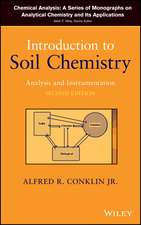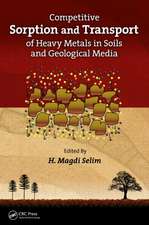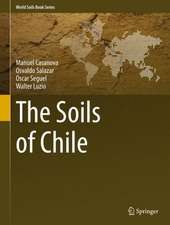Advances in Soil Science: Advances in Soil Science, cartea 6
Contribuţii de R.R. Allmaras, S. C. Gupta, J. Kubota, A. D. Scott, S.J. Smith, D. L. Sparks, M.E. Sumner, D. Van Campen, J.L. Walworth, R.M. Welchen Limba Engleză Paperback – 14 oct 2011
Din seria Advances in Soil Science
-
 Preț: 444.08 lei
Preț: 444.08 lei -
 Preț: 448.67 lei
Preț: 448.67 lei - 25%
 Preț: 427.84 lei
Preț: 427.84 lei - 15%
 Preț: 467.93 lei
Preț: 467.93 lei - 18%
 Preț: 1954.45 lei
Preț: 1954.45 lei - 12%
 Preț: 312.43 lei
Preț: 312.43 lei -
 Preț: 374.21 lei
Preț: 374.21 lei - 25%
 Preț: 941.40 lei
Preț: 941.40 lei -
 Preț: 448.44 lei
Preț: 448.44 lei - 18%
 Preț: 1289.11 lei
Preț: 1289.11 lei - 15%
 Preț: 473.34 lei
Preț: 473.34 lei - 18%
 Preț: 1304.13 lei
Preț: 1304.13 lei - 22%
 Preț: 464.32 lei
Preț: 464.32 lei - 18%
 Preț: 1300.62 lei
Preț: 1300.62 lei - 18%
 Preț: 1941.67 lei
Preț: 1941.67 lei - 18%
 Preț: 1284.86 lei
Preț: 1284.86 lei - 15%
 Preț: 461.03 lei
Preț: 461.03 lei - 18%
 Preț: 1290.23 lei
Preț: 1290.23 lei - 18%
 Preț: 1119.62 lei
Preț: 1119.62 lei - 18%
 Preț: 1290.71 lei
Preț: 1290.71 lei - 18%
 Preț: 1233.70 lei
Preț: 1233.70 lei - 15%
 Preț: 641.38 lei
Preț: 641.38 lei - 15%
 Preț: 636.63 lei
Preț: 636.63 lei - 15%
 Preț: 643.84 lei
Preț: 643.84 lei - 15%
 Preț: 637.46 lei
Preț: 637.46 lei - 15%
 Preț: 701.59 lei
Preț: 701.59 lei - 15%
 Preț: 636.30 lei
Preț: 636.30 lei - 15%
 Preț: 639.59 lei
Preț: 639.59 lei - 15%
 Preț: 638.43 lei
Preț: 638.43 lei - 15%
 Preț: 648.89 lei
Preț: 648.89 lei - 15%
 Preț: 641.71 lei
Preț: 641.71 lei - 15%
 Preț: 637.59 lei
Preț: 637.59 lei -
 Preț: 385.47 lei
Preț: 385.47 lei - 15%
 Preț: 641.85 lei
Preț: 641.85 lei - 15%
 Preț: 637.28 lei
Preț: 637.28 lei - 15%
 Preț: 637.59 lei
Preț: 637.59 lei - 15%
 Preț: 638.57 lei
Preț: 638.57 lei - 15%
 Preț: 637.93 lei
Preț: 637.93 lei -
 Preț: 384.70 lei
Preț: 384.70 lei - 15%
 Preț: 637.28 lei
Preț: 637.28 lei - 28%
 Preț: 1414.85 lei
Preț: 1414.85 lei
Preț: 637.46 lei
Preț vechi: 749.95 lei
-15% Nou
Puncte Express: 956
Preț estimativ în valută:
121.99€ • 132.47$ • 102.47£
121.99€ • 132.47$ • 102.47£
Carte tipărită la comandă
Livrare economică 22 aprilie-06 mai
Preluare comenzi: 021 569.72.76
Specificații
ISBN-13: 9781461291121
ISBN-10: 1461291127
Pagini: 236
Ilustrații: IX, 222 p.
Dimensiuni: 155 x 235 x 12 mm
Greutate: 0.34 kg
Ediția:Softcover reprint of the original 1st ed. 1987
Editura: Springer
Colecția Springer
Seria Advances in Soil Science
Locul publicării:New York, NY, United States
ISBN-10: 1461291127
Pagini: 236
Ilustrații: IX, 222 p.
Dimensiuni: 155 x 235 x 12 mm
Greutate: 0.34 kg
Ediția:Softcover reprint of the original 1st ed. 1987
Editura: Springer
Colecția Springer
Seria Advances in Soil Science
Locul publicării:New York, NY, United States
Public țintă
ResearchCuprins
Potassium Dynamics in Soils.- I. Introduction.- II. General Characteristics of Soil K.- III. Forms of Soil Potassium.- IV. Inorganic and Organic Colloids Important in Potassium Dynamics.- V. Techniques for Measuring Potassium Dynamics.- VI. Equations and Models to Describe Potassium Dynamics in Soils and Clay Minerals.- VII. Effect of Temperature on K Dynamics.- VIII. Dynamics Between Solution and Exchangeable Phases of Potassium.- IX. Kinetics of Nonexchangeable and Mineral Potassium Release.- X. Use of Kinetics for Determining Thermodynamics of Potassium Exchange in Soils.- XI. Summary and Future Research Needs.- References.- Models to Assess the Susceptibility of Soils to Excessive Compaction.- I. Introduction.- II. Definitions.- III. Modeling Laboratory Soil Compaction.- IV. Ease/Susceptibility of Soils to Compaction.- V. Excessive Compaction.- VI. Water Contents and Applied Stresses Not Conducive to Excessive Compaction.- VII. Acceptable Loads Versus Drainage.- VIII. Modeling Field Soil Compaction.- IX. Application of Field Soil Compaction Models.- X. Areas of Future Research.- References.- Sources, Amounts, and Forms of Alkali Elements in Soils.- I. Introduction.- II. Differentiating Characteristics.- III. Geochemistry.- IV. Mineralogy.- V. Soil Content.- VI. Soil Forms.- References.- The Diagnosis and Recommendation Integrated System (DRIS).- I. Introduction.- II. Nutrient Concentration and Aging.- III. DRIS Norms.- IV. Making a Diagnosis: Use of a DRIS Chart.- V. Calculating DRIS Indices.- VI. Nutrient Index Interpretation.- VII. Testing DRIS Norms.- VIII. Comparisons of DRIS and Other Diagnostic Systems.- IX. Effect of Leaf Age and Position on DRIS Indices.- X. Universality of Foliar Norms.- XI. Expansion of DRIS Beyond Nutrient Ratios.- XII. Conclusions.- XIII. References.- Soil-Related Nutritional Problem Areas for Grazing Animals.- I. Introduction.- II. General Considerations of Trace Element Problems in Plants and Animals.- III. Geographical Distribution of Nutritional Problem Areas for Grazing Animals.- IV. General Discussion.- V. Future Outlook.- References.









